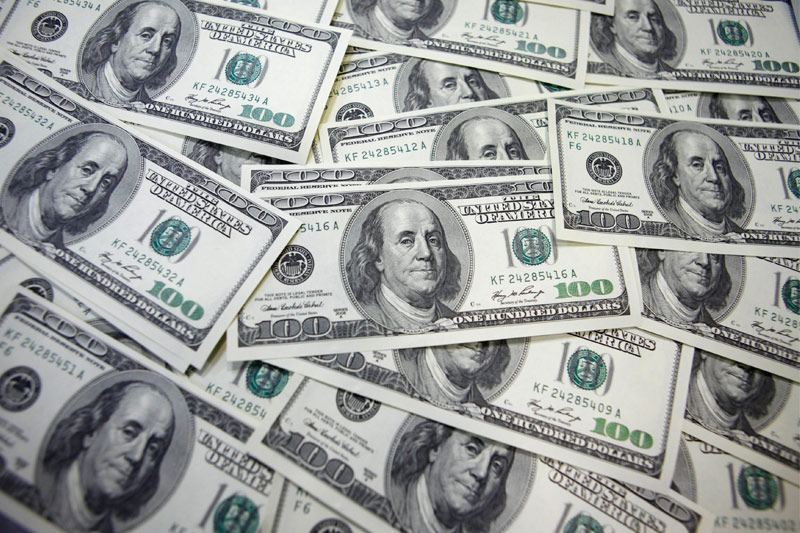Investing.com - The dollar was broadly lower against the other major currencies on Thursday as investors awaited the outcome of policy meeting by the European Central Bank and the Bank of England later in the day.
During European late morning trade, the euro pulled back from session highs against the dollar, with EUR/USD up 0.38% to 1.3016, down from a high of 1.3071.
The euro pared gains after official data showed that German factory orders dropped 1.9% in January, confounding expectations for a 0.5% increase.
The ECB was widely expected to leave rates on hold at 0.75% on Thursday, but concerns over the economic outlook for the region fuelled speculation over the prospect of future rate cuts.
The dollar remained supported after ADP nonfarm payrolls data on Wednesday showed that the U.S. private sector added 198,000 jobs in February, above expectations for an increase of 170,000.
The upbeat data fuelled optimism over a recovery in the U.S. labor market.
The dollar was close to two-and-a-half year highs against the pound, with GBP/USD slipping 0.12% to 1.5000 ahead of the Bank of England’s policy meeting later Thursday, amid speculation over whether the bank will resume its asset purchase program.
Elsewhere, the dollar inched higher against the yen, with USD/JPY edging up 0.07% to 94.14 after the Bank of Japan kept monetary policy unchanged at its policy meeting.
The BoJ left the size of its asset purchase program on hold at JPY76 trillion at Governor Masaaki Shirakawa’s final meeting before incoming governor Haruhiko Kuroda takes over next month.
At a parliamentary confirmation hearing on Monday Kuroda said he would not set any limits on the amount of cash the central bank pumps into the economy.
The greenback was lower against the Swiss franc with USD/CHF sliding 0.21% to 0.9466.
The greenback was broadly lower against its Canadian, Australian and New Zealand counterparts, with USD/CAD slipping 0.07% to 1.0312, AUD/USD climbing 0.29% to 1.0265 and NZD/USD edging up 0.05% to 0.8287.
In Australia, official data showed that the trade deficit widened unexpectedly in January, increasing to AUD1.06 billion from a deficit of AUD0.69 billion the previous month.
The dollar index, which tracks the performance of the greenback versus a basket of six other major currencies, was down 0.12% to 82.45.
The U.S. was to release official data on the trade balance and the weekly report on initial jobless claims later in the trading day.
During European late morning trade, the euro pulled back from session highs against the dollar, with EUR/USD up 0.38% to 1.3016, down from a high of 1.3071.
The euro pared gains after official data showed that German factory orders dropped 1.9% in January, confounding expectations for a 0.5% increase.
The ECB was widely expected to leave rates on hold at 0.75% on Thursday, but concerns over the economic outlook for the region fuelled speculation over the prospect of future rate cuts.
The dollar remained supported after ADP nonfarm payrolls data on Wednesday showed that the U.S. private sector added 198,000 jobs in February, above expectations for an increase of 170,000.
The upbeat data fuelled optimism over a recovery in the U.S. labor market.
The dollar was close to two-and-a-half year highs against the pound, with GBP/USD slipping 0.12% to 1.5000 ahead of the Bank of England’s policy meeting later Thursday, amid speculation over whether the bank will resume its asset purchase program.
Elsewhere, the dollar inched higher against the yen, with USD/JPY edging up 0.07% to 94.14 after the Bank of Japan kept monetary policy unchanged at its policy meeting.
The BoJ left the size of its asset purchase program on hold at JPY76 trillion at Governor Masaaki Shirakawa’s final meeting before incoming governor Haruhiko Kuroda takes over next month.
At a parliamentary confirmation hearing on Monday Kuroda said he would not set any limits on the amount of cash the central bank pumps into the economy.
The greenback was lower against the Swiss franc with USD/CHF sliding 0.21% to 0.9466.
The greenback was broadly lower against its Canadian, Australian and New Zealand counterparts, with USD/CAD slipping 0.07% to 1.0312, AUD/USD climbing 0.29% to 1.0265 and NZD/USD edging up 0.05% to 0.8287.
In Australia, official data showed that the trade deficit widened unexpectedly in January, increasing to AUD1.06 billion from a deficit of AUD0.69 billion the previous month.
The dollar index, which tracks the performance of the greenback versus a basket of six other major currencies, was down 0.12% to 82.45.
The U.S. was to release official data on the trade balance and the weekly report on initial jobless claims later in the trading day.
